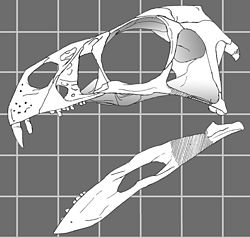Incisivosaurus
|
Incisivosaurus Temporal range: Early Cretaceous, 123.2 Ma |
|
|---|---|
 |
|
| Restoration of the skull | |
| Scientific classification | |
| Kingdom: | Animalia |
| Phylum: | Chordata |
| Class: | Reptilia |
| Superorder: | Dinosauria |
| Order: | Saurischia |
| Suborder: | Theropoda |
| Infraorder: | Oviraptorosauria |
| Genus: |
Incisivosaurus Xu, Wang & Chang, 2002 |
| Species | |
|
|
Incisivosaurus ("incisor lizard") is a genus of small, probably herbivorous theropod dinosaur from the early Cretaceous Period of what is now the People's Republic of China. The first specimen to be described (by Xu et al. in 2002), IVPP V13326, is a skull that was collected from the lowermost levels (the fluvial Lujiatun beds) of the Yixian Formation (dating to the Barremian stage about 125 million years ago) in the Sihetun area, near Beipiao City, in western Liaoning Province. The most significant, and highly unusual, characteristic of this dinosaur is its apparent adaptation to an herbivorous or omnivorous lifestyle. It was named for its prominent, rodent-like front teeth, which show wear patterns commonly found in plant-eating dinosaurs. The specific name gauthieri honors Dr. Jacques Gauthier, a pioneer of the phylogenetic method of classification.
The initial description of Incisivosaurus by Xu et al. showed that the skull, which measures approximately 10 cm (3.9 in) in length, preserves the most complete dentition known for any oviraptorosaurian. Their cladistic analysis indicated that Incisivosaurus lies at the base of the oviraptorosaurian group, making it more primitive than Caudipteryx and the oviraptorids. A subsequent study by Osmolska et al. in 2004 described the distinguishing skeletal features of Incisivosaurus, including a long snout that made up about half the total length of the skull, a slender lower jaw with a long fenestra (opening), and its distinctive, large, flattened front teeth. In addition to these unique features, Incisivosaurus shared many traits with more typical oviraptorosaurs, allowing its classification with that group. Several features, including its numerous teeth (most advanced oviraptorids were toothless), show that it was a primitive member of the group, and several features of the skull even support a relationship with the therizinosaurs, another theropod group that was probably herbivorous.
...
Wikipedia
